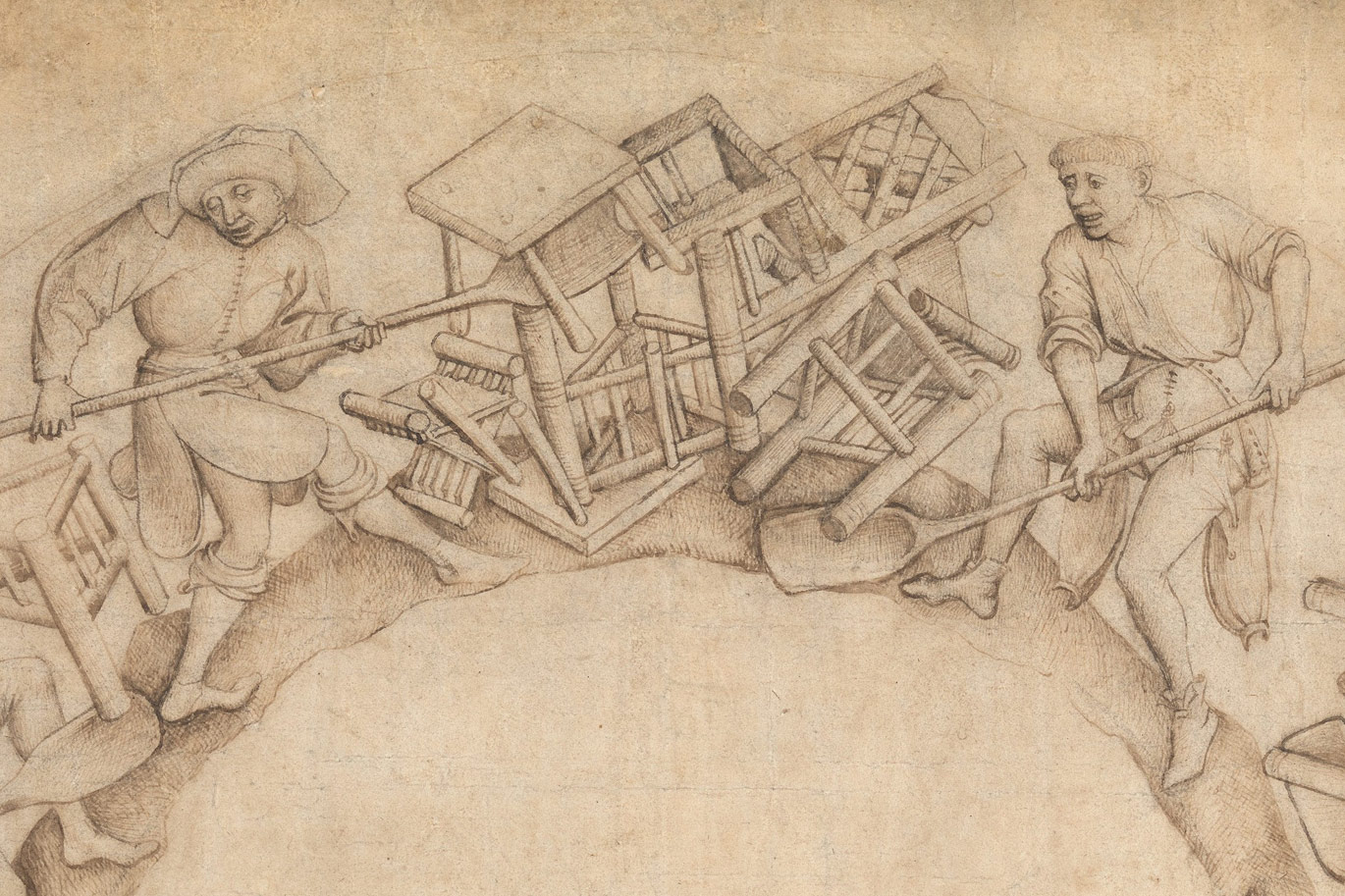- Winter 2020
Syllabus Description:
Art 355: Materials in Context for Interdisciplinary Practice: SOFT SCULPTURE
MW 11:30-2:20 Room: ART207
Instructor: Timea Tihanyi timea@uw.edu Office: Art 209 Office hours: by appointment
Go to Schedule
Go to Required Supplies
First day note: SOA+AH+D First day attendance policy for art classes: Instructors assume that if you are not present for roll call on the first day of a studio art class you have decided not to remain enrolled. If you miss the first day without permission, your seat becomes open and it is your responsibility to drop the course.
Course Description
This interdisciplinary studio course focuses on exploring the meanings and uses; as well as visual, sculptural and narrative potentials of natural fiber materials (wool, paper pulp), fabrics and mixed-media (wire, wax, embellishments, etc.) for sculptural purposes.
This is an interdisciplinary studio course, consisting of a series of studio assignments of soft sculpture, which are primarily 3D applications of soft/malleable sculptural materials, such as fibers (wool and paper), wire, and textiles. Ideas taken from these projects can also be further developed into installations, performances, digital or time-based media. Class time will be spent on technical demonstrations, studio work-time, project consultations, and critiques. Please expect to commit a reasonable amount of studio time/week (appr. 6 hours) outside of class for completing assignments. Some materials will be provided in class but certain projects require you to purchase your own materials to give you more variety of textures and colors. Expect to spend between $30-60, on these, depending on what you are planning to do.
Assignments
There are 3 assignments.
Assignment #1: Alter-ego wearable using felting (with natural wool). We will learn several techniques for wet and dry felting; and design, create a template for, and develop a large wearable sculptural head-ornament.
Assignment #2: Transformation assignment using wire and hand-made paper. We will learn working with wire using jewelry and weaving techniques, then apply paper pulp to develop a skin surface on these structures. The finished objects will be installed in the classroom as free-standing, wall-based or hanging sculptures.
Final assignment: “Finding Your Roots” Collecting various textiles and textile influences from your personal, family and ancestral (ethnic, cultural) history and using them to develop a fabric sculpture that shares a meaningful and significant story about you. We will learn sewing and embroidery techniques, and will be developing the project with these.
Demonstrations will cover various techniques, such as hand and machine sewing; wool felting; working with paper fibers on sculptural armatures. Information on mold-making/casting and CAD/CAM processes (such as laser cutting and CNC) may be discussed, upon request.
All necessary skill will be demonstrated in class and you’ll have the opportunity to practice these during class work times. Experimentation with these basic methods is desired, in order to understand and redefine the forms, material qualities, functions and roles these objects can take.
Roll up your sleeve and bring your curiosity!
Course Objectives
- Gain experience with a variety of sculptural materials.
- Broaden your skill set with different techniques of construction.
- Broaden your understanding of how materials function in various forms and contexts.
- Further your understanding of sculptural concepts, formal elements of 2D, 3D, 4D constructions, and their relationship in space and time.
- Develop fluency with creating interactions between context, material and meaning.
- Gain familiarity with major contemporary art movements and their representatives, whose work addresses our tactile environment and contemporary visual culture.
- Develop projects for your portfolio.
- Most importantly: Challenge yourself! Strive to fresh ideas! Be creative.
Evaluation
Your final grade will be determined by the following:
Assignment #1 + #2 (including preparedness and development of work) 50%
Final Assignment (including research, collection, construction and presentation) 30%
Participation + Professional manner (individual effort, commitment, progress) 20%
Assignment grading will be based on the following criteria:
- Ideation, research and thought process;
- Design and form (including design drawings, mock-ups and models);
- Craft, fluency with demonstrated of techniques;
- Development (evidence of complexity, appropriateness, scale, considerations for presentation);
- Experimentation (going beyond basic, exploring potentials).
Note: Feedback and evaluation of the finished assignment is done during class presentation and critique. Scores on Canvas are a form of documenting the main points of the feedback and evaluating the above aspects of the project. It is important that you consult the rubric to see which areas need more attention, and thus, improvement, and which are those that have been most successful.
The maximum to earn on each criterium is 10pts.
9-10 points: most complete and successful in that aspect;
7-8 points: together in fundamental aspects but has other smaller issues to still resolve;
5-6 point: together in fundamental aspects but has one or two important issues to still resolve,
3-4 points: need significantly more resolution, even in the fundamentals.
0-2: completely unresolved in all aspects.
How does the Final percentage system translate into grades?
| Letter | Number | % |
|---|---|---|
| A | 4.0 | 98-100 |
| A- | 3.9-3.5 | 90-97 |
| B+ | 3.4-3.2 | 85-89 |
| B | 3.1-2.9 | 80-84 |
| B- | 2.8-2.5 | 76-79 |
| C+ | 2.4-2.2 | 73-75 |
| C | 2.1-1.9 | 70-72 |
| C- | 1.8-1.5 | 67-69 |
| D+ | 1.4-1.2 | 64-66 |
| D | 1.1-0.9 | 60-63 |
| D- |
0.8-0.7 Lowest passing grade. |
55-59 |
| E |
0.0 Academic failure. |
55 and below |
Interpretation of the Course Grading Scale:
3.9-4.0 The highest possible performance in all aspects of the course with work exemplifying exceptional quality. Exhibits outstanding creative potential.
3.5-3.8 Exhibits creative potential with superior performance in most aspects of the course; high quality in the remainder. Well prepared for subsequent courses in the field.
3.2-3.4 High performance in most aspects of the course. Very good chance of success in subsequent courses in the field. Exhibits some creative potential.
2.9-3.1 Good performance in some of the course; satisfactory performance in the remainder. Exhibits some creative potential. Good chance of success in subsequent courses in the field.
2.5-2.8 Demonstrates the minimum amount of research needed to complete the course with satisfactory performance.
2.1-2.4 Met basic requirements in most of the course, with the remainder being somewhat substandard.
2.0 and below Did not meet basic requirements for class.
Important information about student conduct
Outside of class:
- Missed assignment due dates and missed assignment critiques will result in no credit for that assignment. Missed demos and class activities will not be offered again, and will result in partial credit.
- Absences from class prevent participation and thus will result in lost participation credits for the day, negatively affecting the final grade.
- Contact the instructor in person by the end of week 2 if you have a planned absence due to religious observation, important family or life event. Plan ahead. Accommodations can only be made with proper notification and planning ahead.
- Contact the instructor via email (timea@uw.edu) as soon as possible if you need to miss a class due to unforeseen emergency (including inclement weather commute, medical, personal or family situation). Set-up a time-line and a plan for make-up of missed demos, work, and deliverables. Accommodations will only be made with proper notification and in consultation with instructor.
- If you must be absent, follow up on Canvas on activities, demos, and assignment guidelines; then with a classmate for class notes and techniques missed; finally, with the instructor if you have specific questions that were not answered by the previous sources.
- If you are sick and contagious, stay at home and get better. If you must miss a class due to illness, let your instructor know immediately and develop a timeline for keeping up with the assignment (see above for unforeseen emergencies).
- Inclement weather/snow: consult UW site for campus closures. If campus is open (classes are held) but you are unable to commute, follow instructions for unforeseen emergency. As soon as you are able to, you are required to check Canvas and UW email for instructor’s messaging with regard to schedule changes (demos, assignments, deliverables and available online resources). Notify the instructor if your commute or internet situation are expected to last past the campus closure day/s.
- Check Canvas regularly, at least twice a week, for updates (Go to Schedule).
In Class:
- Prep work: research, materials, 2D or 3D sketches, material tests, work in progress are an essential part of the development of each project. Make sure to meet the preparation due dates as listed on Canvas Schedule. Failure to do so will result in Development, Participation and Professionalism points.
- Have a sketchbook and collect ideas, research notes and reading summaries, and technical notes in it.
- Participate! Add relevant content to the topical discussions and group activities. Ask questions and interact with the instructor and your peers.
- Use the class work time as your most important opportunity to develop work under guidance. Use the classroom to work outside of class times.
- Electronics (laptops, tablets, phones and other smart devices) are only allowed when the instructor calls for their use. Outside of these times, turn off and put these away.
- No headphones, earbuds in during class time.
- Class begins and ends at the appointed time. We will take breaks as appropriate. Arrive on time and plan to stay for the entire duration of class.
Last day of meeting: CLASS exhibition.
Date: during FINALS WEEK on Tuesday, March 18th, 2:30-4:20pm.
Classroom combo: TBA
Building policies:
Art building is open to the public Mon-Fri, 8am-6:20pm.
After-hours access: must have your Husky card to enter the building at any time, at the loading dock entrance.
Must have card activated via https://art.washington.edu/general-policies (under #18. After-Hours Access).
Renting a locker: visit the Admin Office in Room 102. Lockers are $12 a quarter (cash, check, credit card, and husky card are accepted).
Also see SOA+AH+D policies: Policies-2020.pdf



